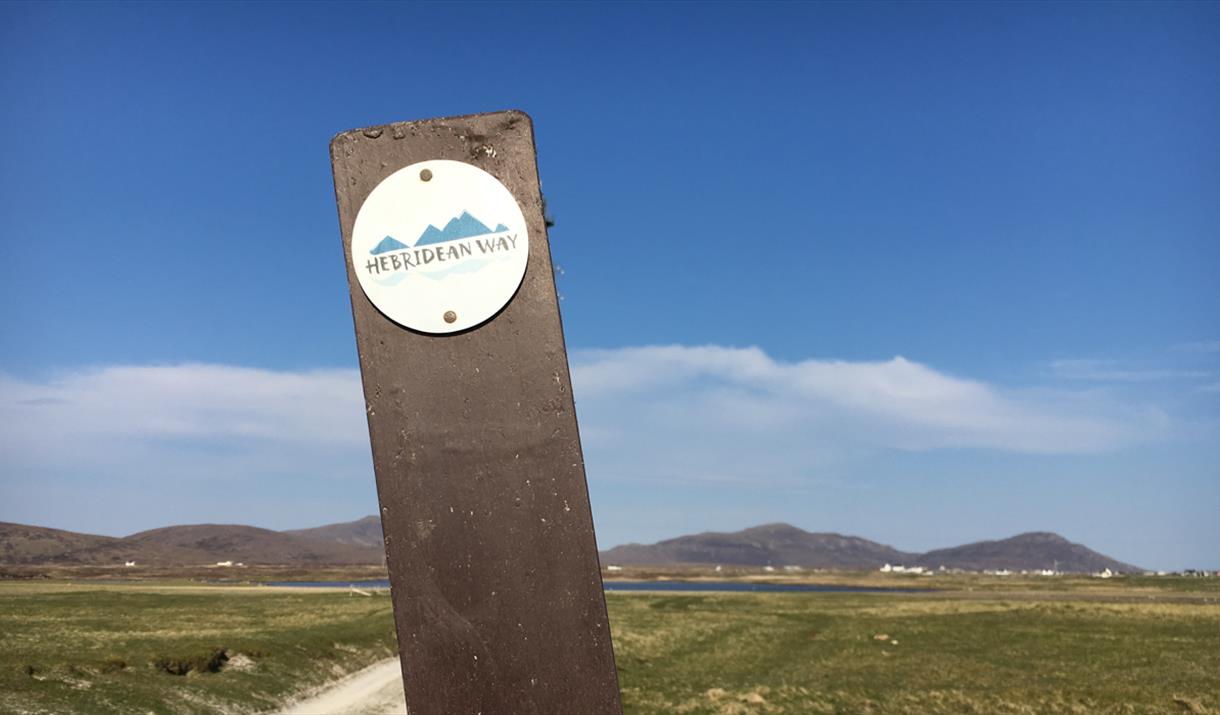About
Height Climbed: 36m / 117ft
Height Descended: 40m / 130ft
Terrain: 10.5 miles of easy walking on grassy / sandy paths and tracks; 1 mile on quiet single track roads.
This is a wonderful day’s walking, slowly following the shoreline as the Hebridean Way works its way up the west coast of South Uist. The skies are big, with countless peaceful freshwater lochs and low lying machair fields stretching away to the hills of Beinn Mhor, Beinn Choradail and Hecla on the eastern skyline.
Machair is formed when peaty soils are enriched by windblown shell sand. The resulting thin but fertile soils have supported islanders for thousands of years – to this day most people on the Uists live here on the west coast, despite its exposure to fearsome winter storms that roar in from the Atlantic.
Crofters on the Uists are keen on their cattle, which need plenty hay to keep them alive over the winter. The resulting meadows are full of wildflowers in the summer months and provide nesting sites for astonishing numbers of lapwings, redshank, dunlin, ringed plovers, snipe and oystercatchers.
The section ends at the beautiful little village of Howmore, home to some atmospheric ruined chapels and an old blackhouse which has been converted into a simple but comfortable hostel.
Apart from the hostel, accommodation options in Howmore are limited. There are a few B&B's within three to five miles or you could stay in Daliburgh, for two nights and use the bus service to pick up and drop you off.
The distances and timings above do not include any extra distance you may need to reach your accommodation for the night. For accommodation, amenities, places to eat at the end of the section, check out the What's Nearby section below.
Map & Directions
- If you have stayed the night at Daliburgh and have walked down to this point, carry straight on, following the road as it heads towards the graveyard in the distance. If you are continuing along the Hebridean Way, turn left at this junction.
- Head up towards Cladh Hallan - you can download the Uist Unearthed App which brings this site to life!
- Turn left at the obvious large aerial onto a good sandy track.
- Opposite 3 wooden posts are the remains of several prehistoric round houses. Known as Cladh Hàlainn, excavations here between 1988 and 2002 showed that the site had been occupied for 4,000 years. In 2001 Cladh Hàlainn gained national fame when archaeologists uncovered a number of 3,500 year old skeletons on the site. Dating from the time of the Egyptian Pharaohs, these turned out to be the remains of the only mummies ever found in Britain.
- Just before the beach a waymarker post indicates the start of a small path leading off to the right.
- For the next 2 miles (3km) it is just a case of following the shore. Depending on the tide you can either walk along the beach, the waymarked path on the seaward edge of the dune, or the frequent grass paths on the dune tops.
- At Askernish the route goes along the edge of a spectacular golf course. Designed in 1891 by Old Tom Morris, the grandfather of modern golf who also created Muirfield and Carnoustie, the course lay hidden under the sand dunes for almost a century before being brought back to life in 2008.
- Eventually you will reach a marker post with an arrow pointing to the right - leave the beach here and walk through the dunes.
- Go through a gate and turn left onto a grassy track.
- Delightful and easy walking follows along grassy and sandy tracks next to the shore.
- At Milton, go through a gate and turn right onto the obvious track leading away from the beach.
- After 200m turn left through a gate and continue on a sandy track across the croft field.
- This soon heads back to the coast where a large track continues around the bay.
- At this point the path meets a tarmac road. The Hebridean Way carries straight on along the coast. Alternatively, a 1 mile (2km) detour up the road will take you to Kildonan where this an excellent museum, café and crafts centre.
- More easy walking across the machair takes you to a large track at Bornais. Go through a gate and turn right onto the track. For an interesting detour head left here and walk onto Rubha Àird a’Mhuile, an impressive headland with the remains of a Viking longhouse and an Iron Age broch, a circular fortified house which was once a common feature in both the Hebrides and Orkney and Shetland.
- Do not cross the cattle grid - the route heads left here, following the fence across a damp, grassy field.
- Continue along the obvious track - do not go through the gate that leads into the field straight ahead.
- The obvious ruins on your right are the remains of Caisteal Ormacleit, one of the last castles built in Scotland. Completed in 1708 by Allan MacDonald, chief of the powerful Clan Ranald, it burnt down a mere 7 years later, reputedly on the same day that MacDonald was killed at the Battle of Sherrifmuir, near Stirling.
- The route continues left here, through a gate and still keeping parallel to the coast. If you fancy a quick look at the castle head up the road for 150m. Please don't enter the castle - it is very dangerous inside.
- As you pass Loch Olaidh an Iar there are excellent views east to South Uist's two highest hills. Hecla (on the left) was named by the Vikings (there are other Heclas on Iceland) whilst Beinn Mhor (the big hill) has a Gaelic name...
- Cross over a small road and continue on a muddy track past a ruined croft house.
- At the next road turn left and walk through the attractive little township of Peninerine.
- At a bend in the road turn left onto a grassy path that runs along the edge of the dunes.
- Carry straight on when you reach a grassy cross roads.
- Turn left when you get to the bridge over the beautiful Howmore River.
- A good track to the right takes you past a church to the hostel at Howmore and the fascinating medieval chapels nearby. Apart from the hostel, accommodation and amenities are sparce in this area. You could stay at Daliburgh or further north and use the bus service.
Along This Route
The famous Flora MacDonald’s Birthplace is in the village of Milton, on the west side of…
Learn about the South Uists local history at Kildonan Museum through stories, artefacts…
On the west side, in the village of Ormiclate is Ormiclate Castle which stands in ruins…
Tobha Mòr has been an important ecclesiastical centre since early medieval times.
Along This Route
Islands: 1 (South Uist)
Causeways: 0
Ferries: 0
Distance: 11.5 miles
Route Time: 4…

















